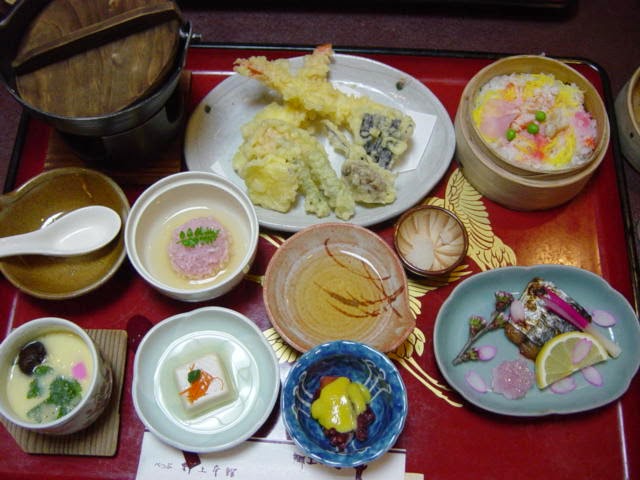Shichijuni-kou (72 Seasons) Calendar Listing
仲春, Chushun: "Mid-spring"
Season No. 4: 春分, Shunbun:
"Vernal Equinox"
 |
| "Sanjusangendo Sakura, Kyoto" (C) 2004 Gen, Genkilee, All Rights Reserved |
Sakura Hajimete Hiraku:
" Cherry Blossoms Begin to Open"
(March 25-29)
The winds of spring wash over Japan in gentle waves, each one warmer than the last, coaxing the sakura (桜 cherry) trees into revealing their beauty hidden within. Weather forecasters and news announcers wring their hands in excited anticipation as they rave about the progress of the sakura zensen (桜前線 cherry blossom front) flowing over the country from south to north.
 |
| Somei Yoshino Cherry Blossoms, Toride City, Ibaraki Prefecture (2007) |
 |
| Pretty In Pink (2001, Maruyama Park, Kyoto) |
Here is where springtime in Japan gets a little confusing. Just when everyone's starting to shake off their winter fat and depression, radio broadcasts and music video programs are flooded with the annual tide of sound-alike sakura themed J-pop songs. Though released by different artists, many of them share similar word imagery, progression, even lyrics, as if written by the same lovelorn junior high school student. They also invariably share a common mood: melancholy.
Here's a list of a few of the more popular sakura songs. Note the recurring themes:
"Sakura Drops" by Utaka Hikaru (the fear of love going wrong)
"Sakura Chiru" by Gackt (love lost and permanent separation)
"Sakura Zaka" by Masaharu Fukuyama (lost love)
"Sakura" by Ketsumeishi (love lost and regrets)
"Sakura" by Kobukuro (the sadness of death and loss)
"Sakura Sake" by Arashi (separation and hope of reunion)
"Sakura (dokushou)" by Moriyama Naotaro (painful goodbyes and the hope of reunion)
"Sakura" by Ikimono Gakari (goodbyes, graduation, separation)
"Sakura No Ki Ni Narou" by AKB-48 (graduation, separation, hope of reunion)
"Sakura Iro Maukoro" by Nakashima Mika (fear of separation, the impermanence of love)
So why the sudden wave of depressing songs in the season of hope and renewal?
The answer can be found in Japan's literary traditions. Classic masterpieces such as Murasaki Shikibu's The Tale of Genji (源氏物語 Genji Monogatari) illustrate how people in the Heian period (794 to 1185 A.D.) would refer to flowers and other lifeforms to represent their emotions through poetry and music.
Of course, this phenomenon is not unique to Japanese culture. But literary theorist Motoori Norinaga (1730-1801) helped bring this concept to light when he coined the phrase mono no aware (物の割られ sorrow at evanescence). Mono no aware refers to the beauty and sadness of the fleeting, temporal nature of all life. This concept is perfectly reflected in the short but sweet eloquence of sakura petals as they open gloriously and flutter gracefully in the wind to their deaths.
Brief and fragile like a 13-yr old girl's emotions, cherry blossoms remind us to savor every moment, every encounter, before they disappear forever.
But in this particular case, I'm quite thankful to be a foreigner. I don't have to succumb to any cultural programming that dictates what I'm supposed to feel or when I should feel it. Just as I don't have to buy presents for Christmas, or sacrifice a goat on Yom Kippur, I don't feel the need to be sad and introspective when I see cherry trees in bloom. I would much rather be happy, having lived through yet another hard, trying winter.
One can look to Japan's culinary culture for uninterrupted enjoyment of spring pleasures.
 |
| Sakura-themed evening meal at Nogami Honkan hot springs lodge, Beppu, Kyushu (2004) |
 |
| Sakura mochi (right) and other sweets of the season. |
There are several kinds of sakura mochi in Japan, but my absolute favorite is Kansai style. A ball of sticky pink mochi rice is stuffed with a dollop of sweet bean paste and the whole thing is wrapped in a sakura leaf pickled in salt and maybe perilla juice if you're lucky. The combination of sweet, salty, starchy and sour goes perfectly with a piping hot cup of bitter coffee or tea.
Since I've waited an entire year for this delicacy, I'm looking forward to going to the store and picking one up. I could apply the concept of mono no aware to this situation, sure, understanding that once I consume that mouth-watering rice ball, I will have nothing left of it, save for the memory and some satisfied gurgles in my gut. But that won't sadden me to the point of writing a lame cookie-cutter song about it. I can understand the thinking behind the Taoist idea that you need sadness to become aware of any happiness in life.
But unlike many Japanese this time of year, I choose not to combine the two. As my father always said, "happiness is a choice." When I see flowers in bloom, I choose to feel only joy. Besides, I don't think the flowers would appreciate knowing that their presence made people sad.
So there.
Copyright 2014 Genkilee, Gen. All rights reserved. No part of this blog (written or photo content) may be reproduced or reprinted without the expressed permission of the author.

No comments:
Post a Comment